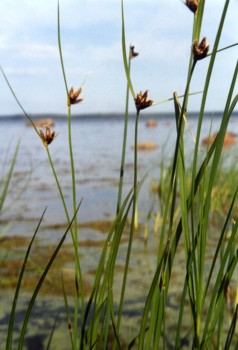Weeds
Bolboschoenus maritimus (L.) Palla - Sea Club-rush
Systematic position.
Family Cyperaceae, genus Bolboschoenus (Aschers.) Palla.Synonyms.
Scirpus maritimus L.Biological group.
This is a perennial tuber plant.Morphology and biology.
Rhizome is creeping, with underground shoots having developed spherical tubers at their ends. Stem is 50-80 (100) cm in height, triquetrous, foliated. Leaves are linear, flat, 3-8 mm wide, rough and usually with 3 apical leaves. Spikelets are ovoid or oblong, dark-brown, 1-2 cm long, sitting in groups of 2-5 on short unequal branches; rarely inflorescences have an isolated sessile spikelet. There are 1-6 perianthal setae. Nutlet is flat on one side, convex on another side, indistinctly triquetrous, with 2-3 stigmas. One reproductive shoot produces 80-250 seeds. Flowering occurs in June - September.Distribution.
This species is found throughout the world (except Arctic regions).Ecology.
Inhabits salt meadows, banks of water reservoirs, former river-beds; grows along mountains up to middle belt. This species tolerates heavy saline soils and water. It prefers alluvial sandy soils. In zones of irrigated agriculture the weed grows in rice fields, along reservoirs, irrigation canals. Seeds can survive for long periods on water surface, transported by water for a great distance. The fresh seeds have low germinating capacity. The germinating capacity increases to 85-92% after winters and frosts. The seeds germinate at depths of not more than 2 cm, and begin to germinate under a soil humidity of not less than 30%.Economic significance.
This is a weed of all cultures growing in conditions of irrigation including rice, Lucerne and grain crops. Control measures include thorough drying of soil. In autumn it is necessary to plow as soon as possible down to depths of 12-16 cm in order to increase the main mass of underground shoots on soil surface. They freeze, dry up and lose germinating capacity by 80-85% during autumn-winter period. In spring, as soon as the soil gets dry, the shoots should be combed out by mainspring cultivator or by heavy peg-tooth harrow. Temporal break between last pre-sowing soil cultivation, sowing of rice and flooding of checkrows should be excluded. In humid spring or on low checkrows of the fallow fields the method of soil and water treatment is possible with the use of assembly of heavy peg-tooth harrow and wood beam on caterpillar tractor. Crop rotation is necessary. Occupied fallows need 2-3 plowings after harvesting. i.e., to depths 12-14, 14-18, and 20-22 cm (tubers covered with soil layer of 10-20 cm thickness sharply lower their germinating ability; tubers covered with soil layer of 30 cm and more do not produce sprouts). The dug-out tubers should be dried thoroughly for 3 weeks after each soil treatment, and then combed out. Those fields should be sown with winter pea in September after preparing the layer. Repeated rice crops must be ceased in 2-3 years.Reference citations:
Bazdyrev G.I., Zotov L.I., Polin V.D. 2004. Weed plants and measures of their control in modern agriculture. Moscow: MSKHA. 288 p. (In Russian)Komarov, V.L., ed. 1935. Flora of the USSR. V. 3. Leningrad: AN SSSR. 636 p. (In Russian)
Nikitin V.V. 1983. Weed plants of the USSR flora. Leningrad: Nauka. 454 p. (In Russian)
Shatalov T.A., ed. 1987. Weed plants and their control in Rostov Region. Rostov-na-Donu: Persianovka. 102 p. (In Russian)
Vasilchenko I.Т., Pidotti O.A. 1975. Manual of the weed plants of irrigate agriculture. Leningrad: Kolos. 376 p. (In Russian)


